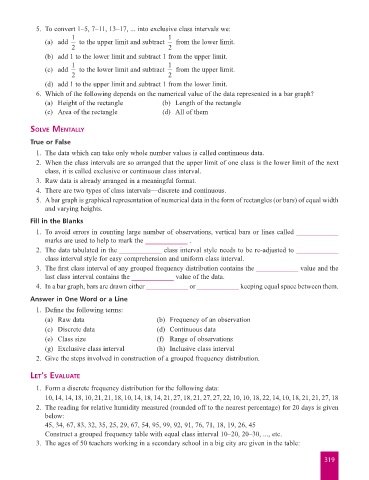Page 327 - Start Up Mathematics_8 (Non CCE)
P. 327
5. To convert 1–5, 7–11, 13–17, ... into exclusive class intervals we:
1 1
(a) add to the upper limit and subtract from the lower limit.
2 2
(b) add 1 to the lower limit and subtract 1 from the upper limit.
1 1
(c) add to the lower limit and subtract from the upper limit.
2 2
(d) add 1 to the upper limit and subtract 1 from the lower limit.
6. Which of the following depends on the numerical value of the data represented in a bar graph?
(a) Height of the rectangle (b) Length of the rectangle
(c) Area of the rectangle (d) All of them
solve Mentally
True or False
1. The data which can take only whole number values is called continuous data.
2. When the class intervals are so arranged that the upper limit of one class is the lower limit of the next
class, it is called exclusive or continuous class interval.
3. Raw data is already arranged in a meaningful format.
4. There are two types of class intervals—discrete and continuous.
5. A bar graph is graphical representation of numerical data in the form of rectangles (or bars) of equal width
and varying heights.
Fill in the Blanks
1. To avoid errors in counting large number of observations, vertical bars or lines called ____________
marks are used to help to mark the ____________ .
2. The data tabulated in the ____________ class interval style needs to be re-adjusted to ____________
class interval style for easy comprehension and uniform class interval.
3. The first class interval of any grouped frequency distribution contains the ____________ value and the
last class interval contains the ____________ value of the data.
4. In a bar graph, bars are drawn either ____________ or ____________ keeping equal space between them.
Answer in One Word or a Line
1. Define the following terms:
(a) Raw data (b) Frequency of an observation
(c) Discrete data (d) Continuous data
(e) Class size (f) Range of observations
(g) Exclusive class interval (h) Inclusive class interval
2. Give the steps involved in construction of a grouped frequency distribution.
let’s evaluate
1. Form a discrete frequency distribution for the following data:
10, 14, 14, 18, 10, 21, 21, 18, 10, 14, 18, 14, 21, 27, 18, 21, 27, 27, 22, 10, 10, 18, 22, 14, 10, 18, 21, 21, 27, 18
2. The reading for relative humidity measured (rounded off to the nearest percentage) for 20 days is given
below:
45, 34, 67, 83, 32, 35, 25, 29, 67, 54, 95, 99, 92, 91, 76, 71, 18, 19, 26, 45
Construct a grouped frequency table with equal class interval 10–20, 20–30, ..., etc.
3. The ages of 50 teachers working in a secondary school in a big city are given in the table:
319

